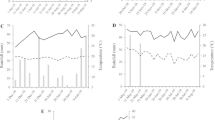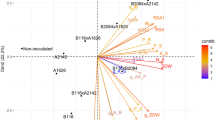Abstract
A plant growth-promoting rhizobacterium (Azospirillum brasilense Sp7) and a bio-control fungus, which can solubilize insoluble phosphorus (Trichoderma harzianum Rifai 1295-22), were evaluated for their single and combined effects on dry bean (Phaseolus vulgaris) and wheat (Triticum aestivum L.) grown in soil. A pot experiment with bean and a field experiment with both bean and wheat were established. In contrast to single inoculation of Trichoderma, the single inoculation of Azospirillum and the double inoculation did not significantly (P >0.05) increase nodule numbers and nodule mass at 45 days after planting in pot grown beans. However, the Azospirillum inoculation with supplementary phosphorus significantly (P <0.05) increased nodule mass. There were no significant (P >0.05) differences among the inoculation treatments for plant dry weight, total plant nitrogen, and total plant phosphorus at 45 days after planting in both pot and field experiments with bean. However, the combined inoculation and rock phosphate application at 1 Mg ha−1 significantly (P <0.05) increased bean seed yield, total seed nitrogen and phosphorus in the bean field trial. This treatment more than doubled the mentioned properties compared to the control. The microbial inoculations, with the exception of the combined inoculation, significantly (P <0.05) increased total seed nitrogen, but never affected seed yield in the wheat field trial (P >0.05). The combined inoculation improves many plant and yield parameters and, therefore, has some advantages over single inoculation provided that rock phosphate was supplied at an amount not exceeding 1 Mg ha−1. Higher rock phosphate application rates decreased many plant and yield parameters in our study.




Similar content being viewed by others
References
Al-Niemi TS, Kahn ML, McDermott TR (1998) Phosphorus uptake by bean nodules. Plant Soil 198:71–78
Altomare C, Norvell WA, Björkman T, Harman GE (1999) Solubilization of phosphates and micronutrients by the plant-growth-promoting and biocontrol fungus Trichoderma harzianum Rifai 1295-22. Appl Environ Microbiol 65:2926–2933
Arauja AP, Teixeira MG, De Almeida DL (1997) Phosphorus efficiency of wild and cultivated genotypes of common bean (Phaseolus vulgaris L.) under biological nitrogen fixation. Soil Biol Biochem 29:951–957
Bashan Y, Holguin G (1997) Azospirillum–plant relationships: environmental and physiological advances. Can J Microbiol 43:103–121
Bashan Y, Levanony H (1990) Current status of Azospirillum inoculation technology: Azospirillum as a challenge for agriculture. Can J Microbiol 36:591–608
Bashan Y, Levanony H, Mitiku G (1989) Changes in proton efflux of intact wheat roots induced by Azospirillum brasilense Cd. Can J Microbiol 35:691–697
Bohn HL, McNeal BL, O’Connor GA (1979) Soil chemistry. Wiley-Interscience, New York
Bremner JM, Mulvaney CS (1982) Nitrogen-total. In: Page AL et al (eds) Methods of soil analysis, part II: chemical and microbiological properties. SSSA, Madison, Wis., pp 595–622
Burdman S, Volpin H, Kigel J, Kapulnik Y, Okon Y (1996) Promotion of nod gene inducers and nodulation in common bean (Phaseolus vulgaris) roots inoculated with Azospirillum brasilense Cd. Appl Environ Microbiol 62:3030–3033
Burdman S, Kigel J, Okon Y (1997) Effects of Azospirillum brasilense on nodulation and growth of common bean (Phaseolus vulgaris L.). Soil Biol Biochem 29:923–929
Buttery BR, Park SJ, van Berkum P (1997) Effects of common bean (Phaseolus vulgaris L.) cultivar and Rhizobium strain on plant growth, seed yield and nitrogen content. Can J Plant Sci 77:347–351
Chavera MH, Graham PH (1992) Cultivar variation in traits affecting early nodulation of common bean. Crop Sci 32:1432–1436
Christiansen I, Graham PH (2002) Variation in dinitrogen fixation among Andean bean (Phaseolus vulgaris L.) genotypes grown at low and high levels of phosphorus supply. Field Crops Res 73:133–142
Cookson P, Goh KM, Swift RS, Steele KW (1990) Effects of frequency of application of 15N tracer and rate of fertilizer nitrogen applied on estimation of nitrogen fixation by an established mixed grass/clover pasture using the 15N-enrichment technique. NZ J Agric Res 33:271–276
Danso SKA, Hardarson G, Zapata F (1988) Dinitrogen fixation estimates in alfalfa-ryegrass swards using different nitrogen-15 labeling methods. Crop Sci 28:106–110
Graham PH (1981) Some problems of nodulation and symbiotic nitrogen fixation in Phaseolus vulgaris L.: a review. Field Crops Res 4:93–112
Graham PH, Ranalli P (1997) Common bean (Phaseolus vulgaris L.). Field Crops Res 53:131–146
Harman GE, Björkman T (1998) Potential and existing uses of Trichoderma and Gliocladium for plant disease control and plant growth enhancement. In: Harman GE, Kubicek CP (eds) Trichoderma and Gliocladium, vol 2. Taylor and Francis, London, UK, pp 229–265
Hendershot WH, Lalande H, Duquette M (1993) Soil reaction and exchangeable acidity. In: Carter MR (ed) Soil sampling and methods of analysis. Lewis, London, pp 141–146
Hjeljord LG, Stensvand A, Tronsmo A (2000) Effect of temperature and nutrient stress on the capacity of commercial Trichoderma products to control Botrytis cinerea and Mucor piriformis in greenhouse strawberries. Biol Control 19:149–160
Isoi T, Yoshida S (1991) Low nitrogen fixation of common bean (Phaseolus vulgaris). Soil Sci Plant Nutr 37:559–563
Itzigsohn R, Kapulnik Y, Okon Y, Dovrat A (1993) Physiological and morphological aspects of interactions between Rhizobium meliloti and alfalafa (Medicago sativa) in association with Azospirillum brasilense. Can J Microbiol 39:610–615
Janzen HH (1993) Soluble salts. In: Carter MR (ed) Soil sampling and methods of analysis. Lewis, London, pp 161–166
Knowles R (1982) Free living dinitrogen fixing bacteria. In: Page AL et al (eds) Methods of soil analysis, part II: chemical and microbiological properties. SSSA, Madison, Wis., pp. 1071–1092
Kundu BS, Kuhad MS, Nandwal AS (1993) Nodulation, nitrogen fixation, and biomass of rajmash (Phaseolus vulgaris L.) as influenced by Azospirillum and Rhizobium inoculants. Environ Ecol 11:581–583
Labandera C, Danso SKA, Pastorini D, Curbela S, Martin V (1988) Nitrogen fixation in a white clover-fescue pasture using three methods of nitrogen-15 application and residual nitrogen-15 uptake. Agron J 80:265–268
Liao H, Rubio G, Yan X, Cao A, Brown KM, Lynch JP (2001) Effect of phosphorus availability on basal root shallowness in common bean. Plant Soil 232:69–79
Murphy J, Riley JP (1962) A modified single solution method for determination of phosphate in natural waters. Anal Chim Acta 27:31–36
Neyra CA, Atkinson A, Olubayi O (1995) Coaggregation of Azospirillum with other bacteria: basis for functional diversity. In: Fendrik I et al (eds) Azospirillum VI and related microorganisms, genetics, physiology, ecology. Springer Verlag, Berlin Heidelberg New York, pp. 429–439
Okon Y, Labandera-Gonzales CA (1994) Agronomic applications of Azospirillum: an evaluation of 20 years world-wide field inoculation. Soil Biol Biochem 26:1591–1601
Olsen SR, Sommers LE (1982) Phosphorus. In: Page AL et al (eds) Methods of soil analysis, part II: chemical and microbiological properties. SSSA, Madison, Wis., pp 403–430
Pacovsky RS (1988) Influence of inoculation with Azospirillum brasilense and Glomus fasciculatum on sorghum nutrition. Plant Soil 110:283–287
Rennie RJ (1986) Comparison of methods of enriching a soil with nitrogen-15 to estimate dinitrogen fixation by isotope dilution. Agron J 78:158–163
Rodelas B, Gonzalez-Lopez J, Martinez-Toledo MV, Pozo C, Salmeron V (1999) Influence of Rhizobium/Azotobacter and Rhizobium/Azospirillum combined inoculation on mineral composition of faba bean (Vicia faba L.). Biol Fertil Soils 29:165–169
Sabatini MA, Grazioso P, Altomare C, Innocenti G (2002) Interactions between Onychiurus armatus and Trichoderma harzianum in take-all disease suppression in a simple experimental system. Eur J Soil Biol 38:71–74
Schroder EC (1992) Improvement of Phaseolus/Rhizobium symbiosis, with particular reference to the Caribbean region. In: Mulongoy K et al (eds) Biological nitrogen fixation and sustainability of tropical agriculture. Wiley, Chichester, pp 79–95
Tang C, Hissinger P, Drevon JJ, Jaillard B (2001) Phosphorus deficiency impairs early nodule functioning and enhances proton release in roots of Medicago truncatula L. Ann Bot 88:131–138
Tchebotar VK, Kang UG, Asis CA, Akao S (1998) The use of GUS-reporter gene to study the effect of Azospirillum-Rhizobium co-inoculation on nodulation of white clover. Biol Fertil Soils 27:349–352
Vanlauwe B, Nwoke OC, Diels J, Sanginga N, Carsky RJ, Deckers J, Merckx R (2000) Utilization of rock phosphate by crops on a representative toposequence in the Northern Guinea savanna zone of Nigeria: response by Mucuna pruriens, Lablab purpureus and maize. Soil Biol Biochem 32:2063–2077
Viera-Vargas MS, de Oliveira OC, Souto CM, Cadisch G, Urquiaga S, Boddey RM (1995) Use of different 15N labelling techniques to quantify the contribution of biological N2-fixation to legumes. Soil Biol Biochem 27:1185–1192
Weaver RW, Graham PH (1994) Legume nodule symbionts. In: Weaver RW et al (eds) Methods of soil analysis: part 2—microbiological and biochemical properties. SSSA, Madison, Wis., pp 199–222
Witty JF (1983) Estimating N2-fixation in the field using 15N-labelled fertilizer: some problems and solutions. Soil Biol Biochem 15:631–639
Yedidia I, Srivastva AK, Kapulnik Y, Chet I (2001) Effect of Trichoderma harzianum on microelement concentrations and increased growth of cucumber plants. Plant Soil 235:235–242
Zimmer W, Bothe H (1988) The phytohormonal interactions between Azospirillum and wheat. Plant Soil 110:239–247
Acknowledgements
We gratefully acknowledge Dr. Wolfgang Zimmer (Universitat Köln, Gyrhofstr, FRG) for providing Azospirillum brasilense Sp7 and Dr. Gary Harman (Cornell University, NY) for the gift of Trichoderma harzianum Rifai 1295-22 commercial inoculant. We thank Dr. Rasim Kocyigit for his critical review of this manuscript. Thanks also go to Dr. Ahmet Yıldırım for his help with the wheat experiment.
Author information
Authors and Affiliations
Corresponding author
Additional information
This work was carried out at Gaziosmanpaşa University, Tokat, Turkey.
Rights and permissions
About this article
Cite this article
Öğüt, M., Akdağ, C., Düzdemir, O. et al. Single and double inoculation with Azospirillum/Trichoderma: the effects on dry bean and wheat. Biol Fertil Soils 41, 262–272 (2005). https://doi.org/10.1007/s00374-004-0818-3
Received:
Revised:
Accepted:
Published:
Issue Date:
DOI: https://doi.org/10.1007/s00374-004-0818-3




